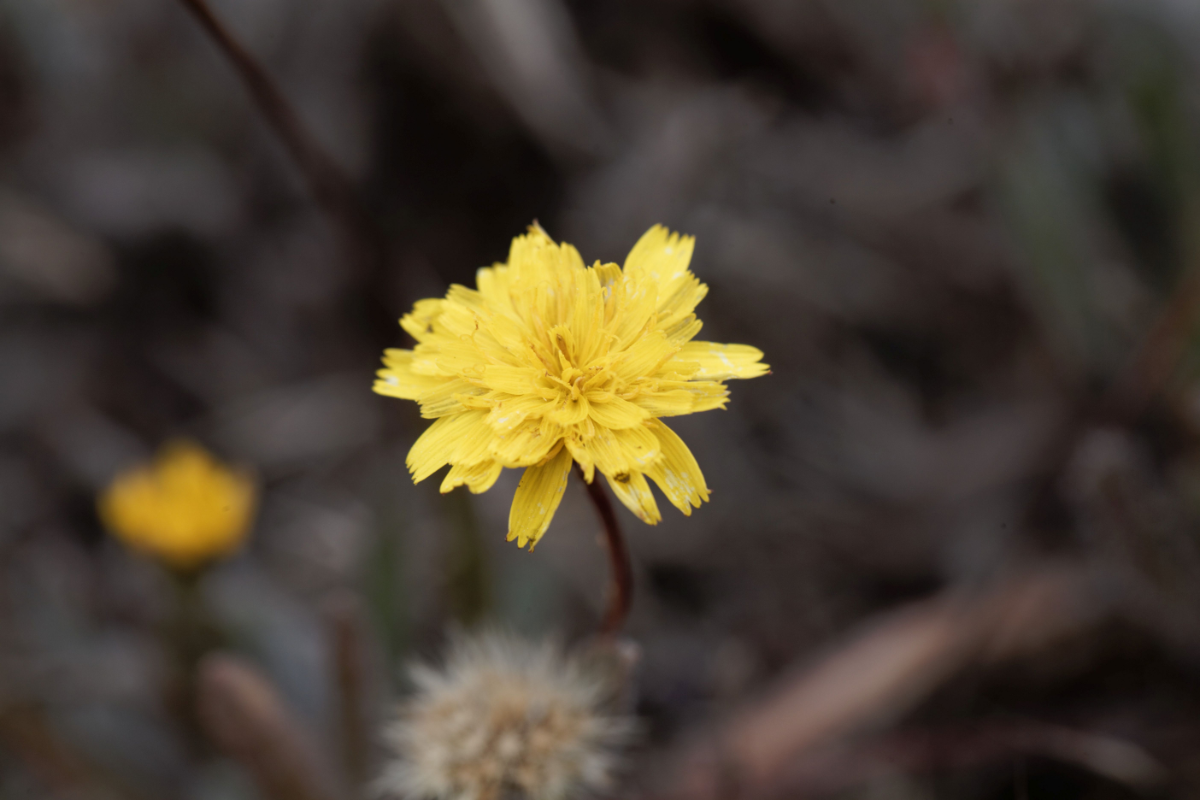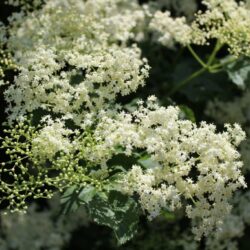Legend has it that a hawk feeds on the juice of hawkweed to improve its eyesight. Hierakon, from which we can guess the Latin name for hawkweed. Hieracium was already the Greek name for several Chicoraceae. But it also contains Hierax, meaning “falcon”. The nameHieracium was therefore given to hawkweed “without any explanation other than popular legend “.
What is hawkweed?
Pilosella (Pilosella officinarum), formerly classified in the genus Hieracium, is a member of the Asteraceae family. It is a flowering plant with a variety of names, such as “hawkweed,” “mouse’s ear,” or “hawkweed It thrives in arid, nutrient-poor environments. It offers a source of natural antibiotics and diuretics.
Its name “Pilosella” refers to the abundant presence of hairs on the plant. Its ancient name “Hieracium” comes from the ancient Greek “Hierax,” meaning “hawk” or “falcon.” This name derives from a popular belief that these birds consumed the plant’s sap to improve their eyesight.
Pilosella is a small, stoloniferous perennial plant, 10 to 15 centimetres high, sometimes 30 cm. It produces elongated shoots around its base. Its leaves are oblong, grey on the underside and covered with long hairs. Its yellow flowers, in solitary upright heads, are smaller than those of dandelions. The fruits are greyish-white achenes topped with a silky aigrette.
Pilosella is widespread throughout Europe (with the exception of the Mediterranean region) and Western Asia up to an altitude of 3,000 metres. It thrives on dry soils, heather moors, earthworks, clearings, rocky outcrops and peat bogs.
In the Middle Ages, its dried edible leaves were used to treat respiratory ailments, liver and stomach problems, and as a poultice for bruises. Modern pharmacology attributes to it anti-infectious, detoxifying, astringent, cholagogue, aperitive, depurative, vulnerary, detersive and diuretic properties. It contains compounds such as umbelliferone . Umbelliferone has antibiotic, antioxidant, anti-inflammatory, anti-hyperglycaemic and anti-tumour properties.
The plant contains various elements, including flavonoids responsible for its diuretic action, glucosides with antibiotic properties, antibacterial phenolic acids and manganese. It is also rich in umbelliferone, which has antibiotic and anti-haemorrhagic properties.
A little history
The choice of the falcon is perhaps not so insignificant, given the bird’s keen eyesight. All of this briefly links us to antiquity, but in those distant times, there was no mention of pilosella; nor is it mentioned by any of the ancient authors. It wasn’t until the twelfth century that we came across it for the first time, in the hand of the great lady Hildegarde. She gave it the name Musore.
Hildegarde explains that pilosella helps to reduce the bad humours accumulated in the body. She was no doubt referring to the diuretic and depurative effects of pilosella, which flushes chlorides, urea and other toxins from the body.
The very name of hawkweed originated in the late Middle Ages, because, as Gaspard Bauhin (1560-1624) points out, hawkweed is copiously hairy. It is described in theHortus sanitatis of 1485 and in theHerbarius of 1536.
In 1554, Matthiole wrote that “physicians have learned that it is a remedy for dysentery and metrorrhagia. In addition, when macerated in slightly bitter wine, it causes wounds, both internal and external, to close: it is a great help against bile vomiting, spitting blood, enteritis, intestinal hernia and all fractures, especially of the skull. There is even no shortage of doctors, especially contemporary ones, who recommend it for ailments of the liver and spleen and in the early stages of dropsy. It is usefully added to drinks for internal wounds and to plasters and balms for vulnerable wounds, because not only does it heal recent wounds, but it also cures stubborn ulcers”.
What are the main pharmacological properties of Hawkweed?
Pilosella is a medicinal plant with interesting pharmacological properties for health. Pilosella owes its therapeutic properties to its rich composition of active ingredients. The compounds identified by researchers include :
- Hydroxycoumarins such as umbelliferone and skimmine
- Flavonoids such as apigenol, luteolin and cynaroside.
- Tannins.
- Triterpenoids such as amyrin, taraxerol and taraxasterol.
- Organic acids, including caffeic acid and chlorogenic acid.
- Vitamin C
- inulin (in the root)
According to the Cahiers de l’Agence (1998), Pilosella is traditionally used for a number of purposes, in particular to facilitate urinary and digestive elimination functions, and to promote renal elimination of water. These properties are attributed to the various active compounds present in the plant, including hydroxycoumarins with diuretic effects, flavonoids with antioxidant properties, tannins with astringent effects, and organic acids which contribute to digestive balance. The presence of vitamin C in Pilosella also adds to its potential health benefits.
Kidney activity
In vitro tests carried out in the late 1940s demonstrated that free umbelliferone has bacteriostatic activity. This coumarin is capable of inhibiting bacterial colonies such as Brucella(abortus and melitensis) and Salmonella typhimurium mainly, but also Staphylococcus aureus and Escherichia coli. Isotein 4′-O-β-D-glucopyranoside, a flavonoid isolated from the methanolic extract of the aerial parts of Hieracium pilosella, inhibits the growth of Pseudomonas aeruginosa. This activity is enhanced by the presence of phenolic acids, which are antibacterial.
This traditionally recognised activity is linked to the presence of flavonoids, which promote the elimination of urea, uric acid and chlorides. The diuretic action of pilosella is also linked to its high inulin content. This compound, a mixture of polysaccharides and oligosaccharides made up of fructose polymers ending in an α-D-glucose linked to this chain, is a fructan that increases osmotic pressure in the renal glomerulus. This action leads to greater elimination of the water filtered by the glomerulus, resulting in a diuretic effect, which also helps to relieve inflammation of the urinary tract.
Pilosella increases vasodilatation of the renal parenchyma, thereby improving glomerular filtration rate.
Hepatodigestive activity
Umbelliferone also has choleretic activity, without a cholagogue effect. The action of the phenolic acids associated with umbelliferone on the quality of bile explains the anti-hypocholesterolaemic action of pilosella. It also has a spasmolytic effect on the sphincter of Oddi. This action is due to the astringent properties of its tannins, as well as its anti-diarrhoeal and intestinal healing properties.
Pilosella has a rich history of traditional use to combat various infections. Research has been carried out to confirm its anti-infective properties by evaluating its effectiveness against common bacterial strains, including particularly virulent strains such as Escherichia coli, Streptococcus lactis, Salmonella typhimurium and Staphylocuccus aureus. The results of these studies revealed that Pilosella does indeed have antibacterial activity, showing notable efficacy against salmonella, a bacterium responsible for many food-borne infections, often linked to gastroenteritis.
In addition to its anti-infectious properties, Pilosella is also renowned for its other health benefits. For example, when consumed in fresh form, it has been shown to reduce blood cholesterol levels. It also acts as a choleretic, stimulating the production of bile. It therefore aids digestion and can help prevent the formation of gallstones.
Studies have also highlighted the benefits of Pilosella in the treatment of brucellosis, an infectious disease caused by bacteria of the Brucella genus. This disease can cause symptoms such as aches, sweating and fever, known as Malta fever, which affects both livestock and humans. As a result, Pilosella is used in both traditional human and veterinary medicine for its anti-infectious properties.
Antioxidant, anti-inflammatory and antiproliferative properties
Polyphenolic compounds, such as those found in Hawkweed, have generally been shown to have an impressive range of health benefits. They are known for their antioxidant, anti-inflammatory and cardioprotective properties. In addition, these compounds have antimicrobial, antimutagenic and antiproliferative effects. Several constituents of Hawkweed, including chlorogenic acid, apigenin-7-O-glucoside and umbelliferone, have been shown to have significant antioxidant activity.
Hawkweed also contains flavonoids and phenolic compounds known for their antioxidant potential. These compounds are capable of neutralising free radicals, thereby reducing oxidative stress and contributing to cellular protection.
Studies conducted in 2011 highlighted the antioxidant effects of a specific flavonoid isolated from Pilosella, also demonstrating its anti-proliferative action against colorectal carcinoma cells. These discoveries pave the way for a wide range of research into the potential uses of Hawkweed.
Hawkweed is being studied for a number of other traditional uses. It shows signs of depurative activity. This makes it a promising candidate for supporting the body’s natural elimination mechanisms. In addition, preliminary evidence suggests that it may have beneficial effects in the treatment of cardiovascular problems, inflammatory diseases and certain types of cancer . Further studies are still needed to confirm these potential benefits.
Finally, Pilosella is known for its cough-stimulating action. It has the power to reduce the production of phlegm. This makes it an effective natural remedy for respiratory disorders such as asthma, whooping cough and bronchitis. It is also used to stimulate energy during convalescence and asthenia. It has healing properties when applied externally. This makes it an effective astringent for controlling bleeding and promoting the healing of wounds and cuts.
Are there any precautions to be taken when using Pilosella?
Before using Pilosella, it is essential to take the necessary precautions to ensure health safety.
The use of Hawkweed during pregnancy or breastfeeding requires prior medical advice. In addition, Piloselle is contraindicated in children under the age of 18 and in patients suffering from severe heart or neuropathy.
To ensure an increase in diuresis, adequate hydration should be maintained throughout treatment. In the case of self-medication with Hawkweed, it is recommended that you consult a doctor or qualified healthcare professional if symptoms worsen during use of the plant. In addition, the occurrence of fever, urinary difficulties, spasms or blood in the urine requires medical consultation.
We advise against using Hawkweed during an attack of renal colic. However, the plant can be used immediately after the attack. Hawkweed is not suitable for treating fluid retention caused by kidney failure or heart failure. The presence of oedema also requires medical consultation.
Pilosella can potentially interact with certain drugs. These include angiotensin-converting enzyme (ACE) inhibitors, angiotensin receptor blockers (Sartan), diuretics, digoxin, antiarrhythmic agents (AAR), corticoids, hypokalaemic drugs and other diuretic plants. The latter can lead to a potentiation of undesirable effects. These include dehydration, renal failure, hypokalaemia and heart rhythm disorders. In addition, Pilosella may increase plasma concentrations of lithium.
It is therefore recommended that you consult a health professional before starting treatment with Piloselle, particularly if you are taking other medicines.
How should I take Hawkweed and at what dosage?
Hawkweed can be taken as an herbal tea . However, we prefer to use fresh parts of the plant, especially to treat mild urinary tract infections. Drying Hawkweed may result in the loss of some of its beneficial properties. The aerial parts of the plant, including the stems, leaves and flowers, are harvested when they flower. They are commonly used in herbal medicine.
There are currently no specific recommendations for dosages or doses of Hawkweed. Current recommendations are based mainly on the traditional use of this plant.
The dosage generally suggested varies between 500 and 1200 mg of Hawkweed powder per day. However, these quantities may fluctuate according to individual needs and the different formulations available for supplementation, as the content of active ingredients may vary from one product to another. If in doubt, it is strongly recommended that you consult a healthcare professional for personalised advice.
- As a dietary supplement in the form of an aqueous dry extract in capsules.
- Standardised fluid extract of fresh plant: 5 to 10 ml per day in a glass of water or in 1L to be drunk throughout the day.
- Infusion: 100g of fresh plant/1L of water for 10 minutes, 1 cup 2 to 3 times a day.
Medical literature and clinical trials
- Stanojevic L. et al, Antioxidant Activity and Total Phenolic and Flavonoid Contents of Hieracium pilosella L. Extracts, Sensors, 2009
- Haag-Berrurier M. et al, Control of the active antibrucellosis principles in Hieracium pilosella L., before and after stabilization. Pharm Acta Helv, 1960
- Adegbola P. et al, Antioxidant and anti-inflammatory medicinal plants have potential role in the treatment of car diovascular disease; a review, Am J Car diovasc Dis., 2017
- Frey F.M. et al, Antivacterial activity of traditional medicinal plants used by Haudenosaunee peoples of New York State; BMC Complement Altern Med, 2010







